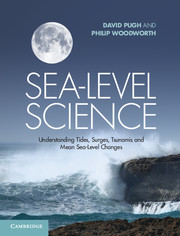Book contents
- Frontmatter
- Contents
- Preface
- List of acronyms
- List of main symbols
- Chapter 1 Introduction
- Chapter 2 Sea-level measuring systems
- Chapter 3 Tidal forces
- Chapter 4 Tidal analysis and prediction
- Chapter 5 Tidal dynamics
- Chapter 6 Shallow-water and coastal tides
- Chapter 7 Storm surges, meteotsunamis and other meteorological effects on sea level
- Chapter 8 Tsunamis
- Chapter 9 Spatial variations in sea level
- Chapter 10 Mean sea-level changes in time
- Chapter 11 Sea-level changes in time to do with the solid Earth
- Chapter 12 Sea-level applications
- Chapter 13 Sea level and life
- Appendix A Basic hydrostatic and hydrodynamic equations
- Appendix B Currents
- Appendix C High and low water times and heights from harmonic constituents
- Appendix D Theoretical tidal dynamics
- Appendix E Legal definitions in the coastal zone
- Glossary
- Index
- References
Chapter 8 - Tsunamis
Published online by Cambridge University Press: 05 May 2014
- Frontmatter
- Contents
- Preface
- List of acronyms
- List of main symbols
- Chapter 1 Introduction
- Chapter 2 Sea-level measuring systems
- Chapter 3 Tidal forces
- Chapter 4 Tidal analysis and prediction
- Chapter 5 Tidal dynamics
- Chapter 6 Shallow-water and coastal tides
- Chapter 7 Storm surges, meteotsunamis and other meteorological effects on sea level
- Chapter 8 Tsunamis
- Chapter 9 Spatial variations in sea level
- Chapter 10 Mean sea-level changes in time
- Chapter 11 Sea-level changes in time to do with the solid Earth
- Chapter 12 Sea-level applications
- Chapter 13 Sea level and life
- Appendix A Basic hydrostatic and hydrodynamic equations
- Appendix B Currents
- Appendix C High and low water times and heights from harmonic constituents
- Appendix D Theoretical tidal dynamics
- Appendix E Legal definitions in the coastal zone
- Glossary
- Index
- References
Summary
Mere anarchy is loosed upon the world,
The blood-dimmed tide is loosed, and everywhere
The ceremony of innocence is drowned.
W. B.Yeats, The Second Coming
Introduction
In the past few years, two giant tsunamis caused by undersea earthquakes have caused major loss of life and damage to coastal infrastructure. On 26 December 2004, a moment magnitude (Mw) 9.3 megathrust earthquake, the third largest on record, took place along 1600 km of the subduction zone from Sumatra to the Andaman Islands in the eastern Indian Ocean [1, 2]. The resulting tsunami waves caused enormous damage, particularly in Indonesia, India, Sri Lanka and Thailand, and killed more than 230,000 people (Figure 8.1) [3, 4]. On 11 March 2011, the Tōhoku (or Sendai) Mw = 9.0 megathrust earthquake, the fourth largest on record, occurred 130 km off the east coast of Japan leaving some 20,000 people dead and tremendous destruction of coastal infrastructure (Figure 8.2), including a major nuclear emergency at the Fukushima Daiichi power plant [5]. These two catastrophic events have had many important consequences including, it will be seen, within sea-level research.
- Type
- Chapter
- Information
- Sea-Level ScienceUnderstanding Tides, Surges, Tsunamis and Mean Sea-Level Changes, pp. 189 - 222Publisher: Cambridge University PressPrint publication year: 2014



